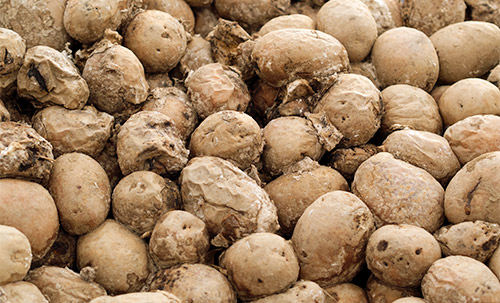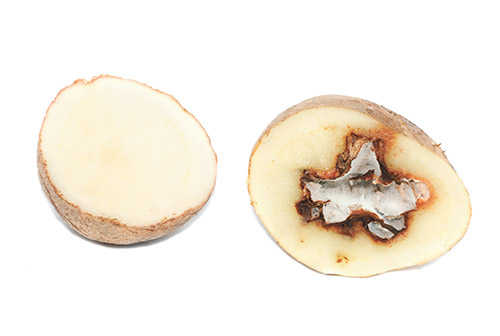



Ready to work with us?
Have any questions?
As a grower you know that the threat of disease in potato storage is real. Your spuds can look healthy going in, but some signs of disease are not apparent to the naked eye. Or, signs of decay and rot may be missed. Threatening spores can lurk within your storage facility, waiting for ripe conditions for taking hold on your precious spuds. Moisture within storage can facilitate the breeding of disease. It is truly the enemy in storage.

Growers work hard through the course of the growing season to realize prime results upon harvest. Ideal storage conditions can keep threatening disease from taking hold. Proper relative humidity(RH), temperature and air flow are key aspects to control in storage. Monitoring and controlling conditions with the best available technology is a grower’s best investment. Industrial Ventilation Inc. (IVI) offers the industry-leading Imperium Control Panel with features that dial in to precise control, factoring an array of variables. An app puts that control right at your fingertips.
Storage buildings can be customized with elements that boost your buildings efficiency and effectiveness. These elements work in tandem to create an ideal environment that can respond to controls for necessary adjustments due to outside conditions. IVI offers humidity control with various humidifiers, as well as our Humidicell evaporative cooler. IVI’s Thermadoor allows for controlling airflow in storage. Fans and heaters are also utilized for the perfect orchestration of climate factors, to the benefit of spuds for storage staying power.
An important component in preventing disease in potato storage is a chemical application for your spuds. IVI offers Jet-AgTM, with application services that make it easy for growers—as easy as making a call for scheduling of the application. Ideally, application is done at the time of storage. Gain peace of mind that behind those closed doors, Jet-AgTM is on a search and destroy mission for any sign of decay or disease. It acts as a desiccant, drying off wet rot, and destroying threatening bacterial and fungal spores. Rated as organic, it breaks down to just water and oxygen. Another option is FruitGardTM—which also kills pathogens, penetrating cuts, wounds and stem scars. It also leaves no residue. Along with the preventative approach, both products can be used upon sign of decay.

Common diseases in potato storage often have indications to look for, helping you to know your threat, and how to best respond. The following is from recent UC-Davis information.1
The fungi that cause dry rot in potatoes are present in most cultivated soils. They are chiefly wound parasites entering tubers through cuts, abrasions, and bruises, or lesions caused by other pathogens. Careful handling during harvest and transport are essential to minimize occurrence of dry rot. Characteristic symptoms are sunken areas of brown, firm rot, often involving a large portion of the tuber. The surface of the affected area is sunken, wrinkled, and frequently with blue or white protuberances. These pathogens are inhibited at temperatures below 40° F, and the fungi becoming increasingly active above 46° F. Infections most frequently occur at harvest.
Soft rot is caused by a bacterium that enters tubers through wounds or through enlarged lenticels which result from excess soil moisture and poor aeration in the field. Soft rot frequently follows tuber damage from frost or bruising and is often a secondary invader following other diseases such as late blight, dry rot, and pink rot. The chief symptom is soft, watery decay of the tuber initially appearing as cavities in the tuber flesh. The decay is often accompanied by a foul smell. On non-russetted cultivars, shallow, circular lesions appear surrounding lenticels. Optimum temperatures for the disease range from 60° to 85° F. Temperatures below 45° F inhibit growth but often tubers are damaged before storage temperatures can be lowered. Storage temperatures below 40 arrest development during storage.
Pink rot and leak are almost identical diseases of tubers caused by closely related soil-borne fungi. Pythium causes leak disease after entering through wounds or abrasions most frequently associated with harvest during high temperatures. Phytophthora may cause a basal stem rot and wilt in tops of plants in the fields, but pink rot disease is primarily one of the tuber. Phytophthora fungus invades through wounds and directly through the eyes of the tuber. Symptoms of both diseases are similar. Characteristically, infected tubers ooze liquid and the tissue becomes flaccid and rubbery. When cut, tubers show a sharp line of demarcation between healthy and diseased tissue. Exposed, affected tissue turns pink then gradually becomes black. As the disease progresses, the tissue develops a granular, mushy rot. Infected tubers usually are invaded by soft-rot bacteria. Growth of the pathogens in tubers is inhibited by low storage temperatures and rapid reduction of storage temperature will prevent spread in storage. The progress of the disease in tubers must be inhibited by lowering the storage temperature below 40°F, or the disease will continue to spread from tuber to tuber. Liquid leaked from infected tubers brings the fungus propagules into contact with healthy tubers and the moisture, with higher temperatures from the heat of fermentation caused by the pathogen and other organisms, makes spread of the disease difficult to stop. Often the result is pockets of rotten tubers within the stored potatoes.
These soil-borne and sometimes seed-borne pathogens may or may not seriously affect the tuber. The visible symptom is a vascular ring discoloration, particularly at the stem end. The disease does not spread from one tuber to another in storage, but secondary infection may occur in affected tubers. The minimum temperature for pathogen growth is 40°F, with an optimum temperature of 75 to 80°F. Because infection occurs in the field, control measures include planting disease-free seed, following good rotation practices, and controlling the organisms in the soil by fumigation.
Tuber symptoms of this disease are small, slightly sunken, dark spots. When warm and moist, the spots become more shrunken and darker in color. Such spots usually do not extend more than 1/4 inch beneath the skin, but soft and dry rot organisms frequently appear as secondary infections. Consequently, a foul-smelling rot often arises from late blight infected tubers.The pathogen is inhibited at 40°F, but grows very rapidly at 60°F and above if the humidity is high. If many tubers are affected, be sure the potatoes are dry when placed in storage and cool them immediately to prevent spread.
Ring rot is a tuber-borne pathogen which causes a yellowish color of the vascular ring just beneath the skin. It cannot be detected, without cutting open the tuber, until it is in an advanced stage. Secondary infections can easily attack infected tubers and quickly destroy them, either in the soil or in storage. The ring rot organism can spread rapidly through a pile. The pathogen is inhibited below 40°F and above 85 to 90°F, and grows most rapidly at temperatures of 65 to 75°F. The best control is to plant disease-free seed. Minimize disease spread by leaving infected tubers in the field and cooling the storage pile as quickly as possible.
Symptoms vary with variety, length of exposure to freezing, and severity of temperature. Injury can usually be diagnosed at harvest by the bluish-gray blotches underneath the skin or by the more uniformly soft, flabby or watery areas on one side of the tuber. Various degrees of internal net necrosis symptoms may occur after freezing. Cold potatoes shatter very easily with handling, allowing secondary rot organisms to enter and grow when the temperature is raised. The only control and prevention is to protect the tubers from freezing temperatures.
Find this content useful?
Sign up for our mailing list to receive more product and industry information and news!
– October 31, 2018